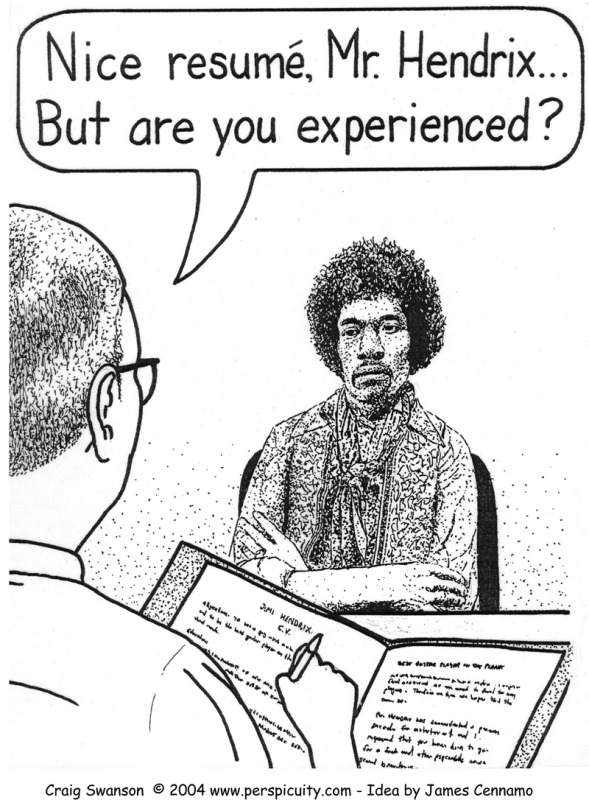 A few months back, I wrote an article about how broken the hiring process is. This article will be a bit similar, but it’s about the recruiting process.
A few months back, I wrote an article about how broken the hiring process is. This article will be a bit similar, but it’s about the recruiting process.
What I’m digging into is how companies design their recruiting process. What steps must a candidate go through? What’s the overall arc of the process like? And is your recruiting process set up in a way that gets you the people you want (or need) to be successful?
At most places, the answer to that final question is “Absolutely not,” and often times the answer is “Exactly the opposite, sir.”
The first thing to understand about a recruiting process
Before we get too deep into this, let’s address two quick things:
- Many a recruiting process isn’t about getting the best people. It’s about covering the ass of HR and the organization. That’s why we steep everything in process and automation. We all secretly know that kind of stuff won’t get us the best people, but we do it anyway because HR is much more about compliance than adding value — and sadly, it always has been.
- Every article about the recruiting process is complete pie-in-the-sky, utopian BS. “Ten Ways To Maximize Your Recruiting Process” by some thought leader? You might as well print that out and save yourself some money on toilet paper this month. If people had any clue about how to manage a recruiting process, we wouldn’t have arrived at 2016 with a broken job market, disenfranchised people, and HR still chasing “a seat at the table.”
Step 1 of the recruiting process: The job description
Actually, Step 1 is “getting the headcount,” and even that step is fraught as hell.
For new positions, it’s usually which manager barks the loudest. It has almost nothing to do with “what the company really needs at the time.” It’s cooler to hire a “financial analyst” than an “admin,” even if you really need the admin more.
Same deal with any job title that has the word “strategist.” Often times there’s no strategy involved at all, but it makes a higher-up feel good that he just hired one.
Once headcount is granted, we move over to job descriptions and posting the job online. Here’s what most companies do: someone just held a job for six years, but instead of updating the description with what that person did well/not well, they edit two sentences (which somehow takes them six weeks to do) and re-post it.
All about chasing those A-Players, baby!
The worst aspect of this stage — besides everything — is the “essential requirements” list. You’ve all seen these. There are 12-15 bullet points detailing skills and degrees you need. If you have 11, you’re kaput. If you have nine? Don’t bring that weak sauce over here, candidate! You’re dead in the water!
 Most companies use applicant tracking systems in their recruiting process — technology killed recruiting — and ATS usually screens out people who don’t hit all the targets immediately.
Most companies use applicant tracking systems in their recruiting process — technology killed recruiting — and ATS usually screens out people who don’t hit all the targets immediately.
Right here, in Step 1, you’ve lost a bunch of great people because of complete BS, not-priority-aligned guesses (yes, guesses — that’s what they are) about what this position needs.
All that and we’re only at Step 1 of the recruiting process!
Step 2: Sourcing and active vs. passive candidates
Now, you start sourcing. At my last gig, my boss (who basically inspired this) got in this huge fight with human resources once about how candidates were being sourced and who was getting through. Of course, it was for a job that barely needed to be filled. Influence matters more than logic in headcount, as noted above.
There’s a prevailing methodology in HR and recruiting now that “passive” candidates are better than “active” candidates. Active candidates are people who apply to your posting. Passive are those you hunt, stalk, and “source” on LinkedIn and through referrals. Liz Ryan addressed the whole “active vs. passive” debate on Forbes.
People seem to think “passive” candidates are diamonds in the rough. You found them! You stole them! Maybe from a competitor! (Giggles with glee!)
In reality, passive candidates can have the same flaws as active candidates. We’re all human beings, you know? And if some middle manager is barking about headcount, a passive candidate is likely (logically) to take longer to hire. “I got seats to fill, Tim! I need an A-Player now!”
The recruiting process funnel is essentially a bigger punchline than childhood celebrity. If you start with 100 people, your outdated garbage of a recruiting process will probably eliminate 70 good people, alienate another 10 people with some modicum of self-esteem or professional belief in their abilities, and now you’re down to 20 also-ran posers.
This is how we build innovative cultures? Wow.
Step 3: Interviews and screenings
I covered this once: the 10 most common interview questions do absolutely nothing to advance a hiring process. It’s also generic BS stacked on top of each other. “Tell me your biggest weaknesses, Gordon.” (pause) “Well, ma’am, I am just such a perfectionist.”
We all know how to game these questions. We’ve all sat through them. They mean nothing. It’s all designed to see if HR — and then the hiring manager — likes the person or feels there’s a “fit.” Essentially, it’s a giant exercise in subjectivity, with all the while everyone claiming that subjectivity is being reduced.
It’s a giant lie. I love it.
I once had a hiring process with a company in Tampa and had six interviews with them, OK? Six different people and all that. Different roles and responsibilities and everything.
This recruiting process stretched out for two months as a result. All six people? They all asked me the exact same questions. Even though they had different levels of power and would have connected to my hiring differently, it was all small talk BS and “walk me through your resume.”
After all that — two months, six interviews, and the same five questions six times over — I got passed over. And of course, I had no reason, context, background, or anything else given.
Let’s say each of those interviews was 30 minutes. That’s three hours of my life I will never, ever get back. That leads to the next point.
Why are candidates treated like a nuisance?
Stop me if you’ve ever gotten this email before:
“We’re aiming to move quickly on this, Tommy, but the hiring manager is out for the next 12 days at trade shows and on vacation.”
OK, you think. So they will follow up in 14 days.
“As I explained earlier, Tommy, it’s a very busy time for us here at Widgets Inc.”
Whoa. Did Tommy just become a bad guy? No crap; Tommy did indeed become a bad guy.
The entire recruiting process is built around this idea that candidates are a nuisance, even as executives inside the company are bellowing about “needing the best talent possible.” Well, if you’re courting the best talent possible, and people who will soon contribute to your bottom line, maybe you should show them some respect? Like, a little bit of respect?
It’s an absolutely incredible disconnect between how we deal with candidates and how we deal with customers. It literally boggles the mind.
Now, yes; your customers buy things and make you money. But you don’t think one of those candidates might some day make you money too? Yes, he or she will. That’s why you need treat them with respect, not as a nuisance.
Step 4: Final stages, offers, and onboarding
I understand the whole deal legally, but getting screened off for a job with no feedback is disconcerting. Of course you always get the “Happy to talk!” email from the hiring manager, but that’s complete BS.
Because I’m a jerk, I’ve followed up on about 20-25 of those in my life.
How many times have I actually ended up talking to the hiring manager who decided to go another direction? Approximately once. If you’re scoring at home, I think that is 4 percent. Hardly a high response rate, yeah?
Offers are usually a joke, too. Most people, because of notions about professionalism and respect, haven’t talked about money until this stage. It’s a dirty little secret that no one really understands their salary anyway, but whatever. Let’s gloss that over for the time being.
 So now you’ve got this offer coming, and you want to know about the cheddar. Usually someone will low-ball the hell out of you (unless you’re an executive, in which case they’ll throw buckets of cash at you with no context).
So now you’ve got this offer coming, and you want to know about the cheddar. Usually someone will low-ball the hell out of you (unless you’re an executive, in which case they’ll throw buckets of cash at you with no context).
This comes about from some other annoying parts of the recruiting process, namely:
- “How much were you making at your last job?“
- “We don’t have a defined salary for this position yet.“
Bullet 1 = You have no necessity to answer that question.
Bullet 2 = That’s absolute garbage. No financial team would ever let head count be approved without a specific salary band attached to it.
Again, this is all lies, garbage, and disrespectful nonsense. We slap a bow on this and call it our talent-centric recruiting process. In reality, it’s hogwash.
Don’t even get me started on onboarding — I’ve written about that enough to choke a horse. See here, here, and here.
Can we improve the recruiting process?
At this point, I don’t know what’s next. The core problem is that recruiting runs through HR, and executives don’t care at all about HR. As a result, no one will ever prioritize improving their recruiting process.
The second issue, adjacent to that one, is that HR barely has the right to be called “human” anymore.
As you can see above, and you may have lived through, many a recruiting process is based almost entirely on,
- Automation; and,
- Treating you like you’re annoying them because you want to someday have a salary and a life.
How is either of those things human? I fail to see that they are.
The fastest path to improving the recruiting process would be better research and metrics on how hiring ties back to the bottom line. Then executives would care more and there’d be more incentive to better a company’s recruiting process. As of now, most discussions about “talent strategy” are lip-serviced manure.
You could also move recruiting out of HR, but that idea might terrify a many people.
Here’s the bottom line, though: Your recruiting/hiring process is designed, ideally, to get you the right and best people to move your company forward.
But, uh, is your recruiting process doing that? Or, is it just alienating the exact type of people you really DO need?
Authors
Ted Bauer
Originally from New York City, Ted Bauer currently lives in Fort Worth, Texas. He's a writer and editor for RecruitingDaily who focuses on leadership, management, HR, recruiting, marketing, and the future of work. His popular blog, The Context of Things, has a simple premise -- how to improve work. Ted has a Bachelors in Psychology from Georgetown and a Masters in Organizational Development from the University of Minnesota. In addition to various blogging and ghost-writing gigs, he's also worked for brands such as McKesson, PBS, ESPN, and more. You can follow Ted on Twitter @tedbauer2003, connect with him on LinkedIn, or reach him on email at [email protected]
Recruit Smarter
Weekly news and industry insights delivered straight to your inbox.





